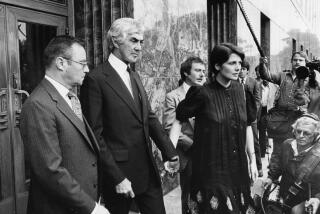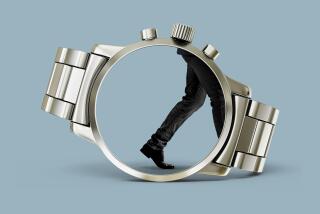Dream Cars : BEFORE DELOREAN, . . . THE TUCKER
- Share via
DETROIT — Long before there was John Zachary DeLorean, there was Preston Thomas Tucker.
Separated by nearly 40 years of tail fins, chrome and controversy, Tucker and DeLorean were really the same at heart--”car guys,” Detroit risk takers with high-octane blood who knew how to hook America into their heroic, ill-starred dreams.
Both were cocky and handsome free spirits who briefly caught the nation’s fancy with their heady promises to produce the “car of tomorrow, today” for an auto-hungry public.
Charismatic renegades, Tucker and DeLorean vowed that theirs would be safe, high-technology beauties with features way ahead of their times; the kind of cars, Tucker and DeLorean would say, that Detroit’s Big Three were too lazy to provide.
Both got governments to give them huge factories, only to claim later that they were being hounded out of business by government-led conspiracies.
And both took ill-prepared prototypes on whirlwind publicity tours to sell stock and sign up dealers for their fledgling companies.
In the end, neither built many cars. Both men, their companies in shambles, landed in federal court amid charges of fraud. Eventually, both were acquitted.
Con men or pioneers crushed by the Establishment? In each case, the American public was left to draw its own conclusions.
It may take another 40 years for a nostalgic car buff, who just happens to be a famous Hollywood director, to make a movie about John DeLorean’s quixotic adventures. But next month will bring the premiere of “Tucker: The Man and His Dream,” Francis Ford Coppola’s big new movie about Preston Tucker and his doomed “Tucker ’48.”
Take away DeLorean’s trial and acquittal on cocaine trafficking charges, and the Tucker and DeLorean stories are uncannily alike.
“Oh, sure, I see similarities,” says DeLorean, who is still trying to prove that General Motors pressured the British government into destroying his Northern Ireland sports car operation in the early 1980s. “You give it a shot. . . . You know it’s better to have loved and lost than never to have loved at all,” he said in an interview.
“I’ve thought about the similarities between my father and DeLorean quite a bit,” adds Marilynn Lee McAndrew, of Ypsilanti, Mich., Tucker’s daughter, who is portrayed in the movie as dousing her father with champagne as she christens the first Tucker car.
“I imagine there will be a movie about (DeLorean) someday, too.”
Were Detroit’s big boys, fronted by a cabal of Washington politicians, out to get Preston Tucker?
Tucker thought so. In a 1953 article, three years after he was acquitted of fraud--and three years before Tucker died of lung cancer at 53, he laid out his case.
“The truth is that of the 31 charges in the four-month trial that resulted in my complete vindication, there was only one charge omitted,” Tucker wrote in Cars magazine. “To that charge I plead guilty: My car was too good.”
Tucker’s story began in the heady days at the end of World War II, when the nation was lusting for cars and other consumer products. There hadn’t been any new cars since 1942--all the factories had been converted to war production--and everyone wanted to hear from Detroit about its postwar plans.
Breakthrough Features
As the war ended, Tucker was turning out gun turrets at his tool and die shop in Ypsilanti.
But Tucker, a racing enthusiast who had briefly built race cars for Henry Ford, was already thinking about mass-producing a car of his own. He hoped to adapt many advanced design concepts he picked up from racing, and some of his engineers had been working on designs even before the war was over.
Soon, he announced plans for an innovative car with breakthrough features that he claimed would race past the Big Three. Magazine stories about the proposed Tucker car created a rush of interest nationwide, and thousands of letters poured in from potential customers and dealers who had read of Tucker’s plans.
The problem was, there was no prototype Tucker car, no Tucker factory, no Tucker auto company. But Tucker never lacked for ideas, and he had plenty about how to equip his car.
Many features were progressive concepts only later incorporated by the major American auto makers: disc brakes, aerodynamic styling, individual wheel suspension, an air-cooled, high-power engine in the rear built of lightweight aluminum, a dashboard with crash padding and a breakaway windshield to reduce head injuries. (The Tucker’s most distinctive feature--its third headlight, a middle “eye” that was supposed to swivel with the wheels to improve night visibility on turns--never did catch on, however.)
Perhaps the most surprising aspect of the Tucker story is how quickly an unknown was able to get into the big business of car making.
Backed by a small group of auto executives who left the Big Three to join him, he surprised observers by obtaining a lease on what was then the biggest manufacturing plant in the world--a Chicago airplane engine factory operated by Dodge for the government during the war--that the government wanted to get rid of at the end of the war. In his 1953 article, Tucker claimed that he was able to get the plant because the federal government didn’t want to turn huge plants built for the war effort over to the already powerful Big Three auto companies.
Quickly, he and his small band began to develop a prototype car, signed up dealers and started selling a $20 million worth of stock to the public.
Saw a Conspiracy
But Tucker ran into trouble almost immediately. His use of the Chicago plant was briefly challenged by Washington public officials; the Securities and Exchange Commission delayed his stock offering and mounted an investigation of his claims about the car and his finances.
In the end, he was able to raise only $15 million, and Tucker allies complained that was partly because of the stock sale being barred in California and Michigan, the auto industry’s friendliest turf.
Tucker was forever bitter about what he saw as a conspiracy to destroy him for challenging the Big Three. He complained that his company’s death blow came when Harry McDonald, an SEC commissioner from Detroit, leaked news of the agency’s investigation to the press.
McDonald was close to Sen. Homer Ferguson of Michigan, an ally of the auto industry who is portrayed as Tucker’s chief adversary in Coppola’s movie.
Some historians disagree with the conspiracy theory. “I don’t think the Big Three did Preston Tucker any favors,” says David Lewis, professor of business history at the University of Michigan. “But I just don’t think the Big Three gave two minutes of thought to him. They didn’t expect him to succeed, and he didn’t let them down.”
Indeed, apart from any possible plot against him, it seems clear that Tucker’s biggest problem was simple--he never had enough money. Even in the 1940s, $15 million--even $20 million--wasn’t enough to start a car company.
“He was grossly undercapitalized,” Lewis says. “He was a promoter. He always had big plans, and he always had trouble getting money to fulfill them. He was well known in Detroit automotive circles, but not everybody thought as highly of him as he did of himself.”
His financial troubles snowballed even before production began. In 1947, the chairman of Tucker’s company quit, claiming that Tucker used “fast-sell” practices. He said Tucker was overly promoting stock on the basis of one hurried, poorly built prototype.
‘Came Awful Close’
Indeed, there was only one crude prototype ready for the first and only Tucker stockholder meeting in 1948, and that car could barely run. “He rushed the prototype too fast,” says Preston Tucker Jr., Tucker’s oldest son, who worked closely with his father. “I wish we had more time, but we were fighting time. We had to get the car out.
“But we still had a great car,” adds Tucker, now an engineer with Motorola in Arizona. “We came awful close.”
Soon, false but damaging rumors began circulating that Tucker’s futuristic car couldn’t go into reverse. Then, after production finally began in 1948, syndicated columnist Drew Pearson leaked word of federal investigation into the company, destroying public confidence in Tucker just as he was starting to roll.
Tucker was forced to shut down after building just 50 models in 1948. His plant was repossessed, and he and seven other company officials went on trial for stock fraud in 1949. The government charged that Tucker had misspent millions, never got close to mass production and never designed a car with the innovative features promised.
Tucker claimed that his indictment was “a rape of the free enterprise system.” To prove his cars were sound, he had a few deliver company documents to the courthouse in Chicago.
But although he was acquitted, he never made a comeback. He died dreaming of building cars in Brazil.
“Had he lived, he would have accomplished everything,” insists his daughter Marilynn, still proud after all these years. “He wasn’t a man to say no.”
But maybe Tucker did have the last laugh. About 45 of his cars are still in existence, many still roadworthy. Coppola owns two.
Originally sold for $1,800, they are now worth about $100,000 apiece.






